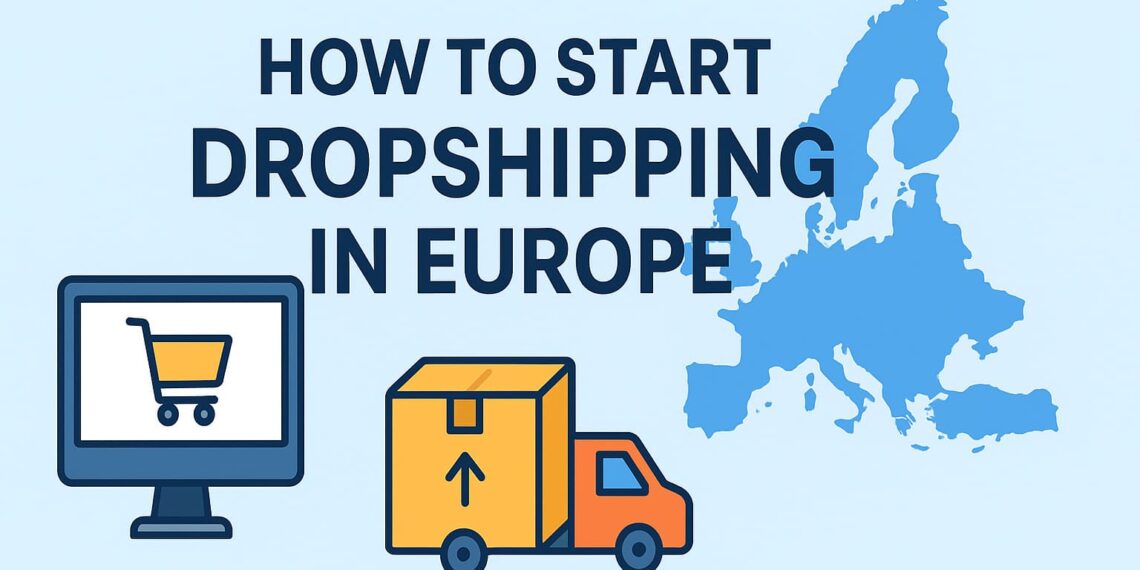How to Start Dropshipping in Europe (Complete Beginner’s Guide)
Dropshipping is one of the easiest ways to start an online business in Europe. Many people choose dropshipping because they want to sell products without holding stock. This model is flexible, low-cost, and beginner-friendly. This guide explains what dropshipping is, how it works, and how to set up your own store in Europe. You will also learn how to find suppliers, handle VAT, and get special tips for selling from the Netherlands.
What Is Dropshipping?
Dropshipping is an online business model where you run a store without storing any products. When a customer buys from your store, you order the item from a supplier. The supplier ships the product directly to the customer. You never handle inventory or shipping yourself.
Why Many People Choose Dropshipping
Dropshipping offers many benefits for new online sellers.
Key benefits include:
- Low upfront costs.
- Easy to launch and scale.
- Flexible work location.
- Test new products quickly.
However, there are risks too.
- Thin profit margins.
- High competition.
- Bad suppliers can hurt your reputation.
- You rely on others to ship on time.
Is Dropshipping Legal in Europe?
Yes. Dropshipping is 100% legal in Europe. But you must follow local rules.
What to do:
- Register your business if you sell regularly.
- Register for VAT if you pass the annual sales limit.
- Follow GDPR to protect customer data.
- Use secure payments.
Example: In Germany, you register for VAT if you earn over €22,000 per year. In the Netherlands, the limit is €20,000. Always check your local rules.
How to Start a Dropshipping Store in Europe
You can start in six simple steps.
1️⃣ Choose a Profitable Niche
Many new sellers fail because they try to sell everything. Pick one clear niche. This makes it easier to target the right customers.
Good niches in Europe:
- Eco-friendly products.
- Yoga and fitness gear.
- Pet supplies.
- Kitchen gadgets.
- Custom mugs and shirts.
Use Google Trends to check demand. Also, ask yourself if the products are easy to ship.
2️⃣ Find Trusted European Suppliers
A good supplier is key. A bad supplier can ruin your store.
Top EU-friendly suppliers:
- Spocket: Many EU suppliers with fast shipping.
- Syncee: Good network in Europe.
- BigBuy: Spanish dropship wholesaler with EU warehouses.
- Printful: Great for custom print-on-demand.
Tips:
- Order a sample first.
- Check shipping speed.
- Read real reviews.
- Look for clear return policies.
Many beginners use AliExpress. However, shipping from China can take weeks. EU suppliers ship much faster.
3️⃣ Build Your Online Store
You do not need to code to open a shop. Many tools help you build fast.
Shopify is very beginner-friendly. You pay a monthly fee, but setup is easy.
WooCommerce is free and works with WordPress. You need more setup, but you get more control.
Your store must include:
- Product pages with clear photos.
- Simple descriptions.
- Shipping and return info.
- Privacy policy and terms.
- Contact page.
Always use SSL to protect customer data.
4️⃣ Handle VAT and GDPR
VAT is important in Europe. If you pass your country’s limit, register for VAT. Add VAT to your prices and report it.
If you sell to other EU countries, you may need the EU One-Stop-Shop (OSS). This makes cross-border VAT easier.
Keep all receipts and invoices. Use software or an accountant if needed.
GDPR requires you to protect customer data. Add a privacy policy and cookie consent. Never spam.
5️⃣ Get Visitors to Your Store
Your store needs traffic to sell. Use both free and paid ways.
Free Traffic
SEO Blogging
Write helpful blog posts that match your niche. For example, if you sell kitchen tools, write “Top 5 Kitchen Gadgets for Small Apartments.”
Pinterest
Post product photos, infographics, and ideas. Pinterest works well for home, fashion, or wellness.
TikTok & Instagram Reels
Short videos get huge reach. Show how your product works, unboxings, or quick tutorials.
Paid Ads
Facebook Ads
Start with €5–€10 per day. Test different pictures and audiences.
Google Shopping
Good for buyers ready to buy now. Your products show up when people search.
Retargeting
Add a Facebook Pixel or Google Tag to show ads to people who visited your store before.
6️⃣ Use Email Marketing
Many new store owners skip email. Big mistake!
Build an email list.
- Offer a discount to collect emails.
- Send updates about new arrivals.
- Give loyal customers special deals.
Tools like Mailchimp or ConvertKit are easy to use.
Common Dropshipping Mistakes
Avoid these common mistakes:
- Picking unreliable suppliers.
- Ignoring VAT and GDPR.
- Selling low-quality products.
- Slow customer service.
- No product testing.
Special Tips for Dropshipping in the Netherlands
The Netherlands is great for EU dropshipping. It has strong shipping hubs and fast couriers like PostNL.
If you earn over €20,000 per year, register for VAT. You may also use OSS if you sell to other EU countries.
Top EU suppliers often have warehouses in the Netherlands. For example: BigBuy, Syncee, or Printful.
FAQs
Is dropshipping profitable in Europe?
Yes, if you choose a good niche and focus on quality.
How much does it cost to start?
€100–€300 is enough for your domain, store, and test products.
Do I need a license?
You must register your business and handle VAT.
Can I sell worldwide?
Yes, but start with Europe for fast shipping.
Final Tips
Dropshipping is simple to start but needs hard work to succeed. Pick your niche, test your products, follow EU rules, and keep learning. Grow step by step and stay patient.
Good luck with your dropshipping journey!


